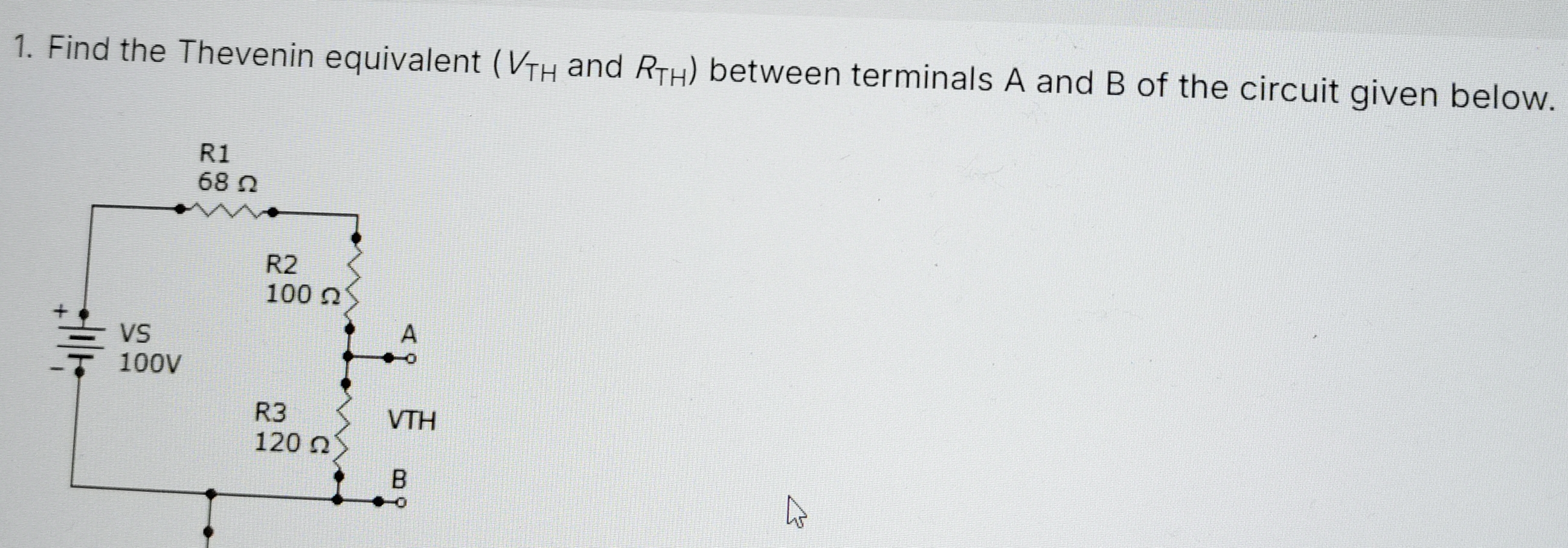Find the Thevenin equivalent (V_TH and R_TH) between terminals A and B of the circuit given below.

Understand the Problem
The question is asking to find the Thevenin equivalent voltage (V_TH) and Thevenin equivalent resistance (R_TH) between two terminals (A and B) in a given electrical circuit.
Answer
$V_{TH} \approx 34.7 \, V$, $R_{TH} \approx 122.55 \, \Omega$
Answer for screen readers
The Thevenin equivalent voltage is $V_{TH} \approx 34.7 , V$ and the Thevenin equivalent resistance is $R_{TH} \approx 122.55 , \Omega$.
Steps to Solve
- Identify the circuit components
Identify the resistances and the voltage source in the circuit:
- $R_1 = 68 , \Omega$
- $R_2 = 100 , \Omega$
- $R_3 = 120 , \Omega$
- $V_S = 100 , V$
- Calculate the total resistance ($R_{TH}$)
To find $R_{TH}$, remove the independent voltage source (replace with a short circuit), then find the equivalent resistance seen from terminals A and B.
Using parallel and series resistance formulas:
- $R_{AB} = R_2 \parallel R_3 = \frac{R_2 \cdot R_3}{R_2 + R_3} = \frac{100 \cdot 120}{100 + 120} = \frac{12000}{220} \approx 54.55 , \Omega$
Now, combine $R_{AB}$ with $R_1$:
- $R_{TH} = R_1 + R_{AB} = 68 + 54.55 \approx 122.55 , \Omega$
- Determine the open-circuit voltage ($V_{TH}$)
To find $V_{TH}$, calculate the voltage across the terminals A and B. Use the voltage divider rule:
-
First, find $I_S$ using Ohm’s Law:
$$ I_S = \frac{V_S}{R_1 + R_2 + R_3} = \frac{100}{68 + 100 + 120} = \frac{100}{288} \approx 0.347 , A $$ -
Next, find $V_{R_2}$ to determine $V_{TH}$:
$$ V_{R_2} = I_S \cdot R_2 = 0.347 \times 100 \approx 34.7 , V $$
Hence,
$$ V_{TH} = V_{R_2} = 34.7 , V $$
- Summary of Thevenin Equivalent
Finally, the Thevenin equivalent voltage and resistance can be summarized as:
- $V_{TH} \approx 34.7 , V$
- $R_{TH} \approx 122.55 , \Omega$
The Thevenin equivalent voltage is $V_{TH} \approx 34.7 , V$ and the Thevenin equivalent resistance is $R_{TH} \approx 122.55 , \Omega$.
More Information
The Thevenin equivalent circuit simplifies complex circuits into a single voltage source and a single resistor. This is particularly useful for analyzing circuits with multiple elements and understanding how they behave at specific terminals.
Tips
- Forgetting to replace the independent voltage source with a short circuit when calculating the Thevenin resistance.
- Not correctly applying the voltage divider rule to find $V_{TH}$.
- Miscalculating the equivalent resistance when combining resistors in series or parallel.
AI-generated content may contain errors. Please verify critical information